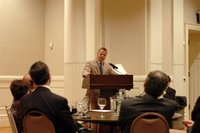This year and this conference I was fortunate to have help with the booth (thanks Joanne), to listen in on comments made by one of our board members and a researcher in his own right Dr. David Rapoport.
The posters this year, as they often are at the ATS meeting, were from all over the world - Perth Australia: The Effect of CPAP on Lower Esophageal Sphincter Function; Valencia Spain: Prevalence of Sleep Apnea Syndrome in Patients with Severe Pneumonia; Fukuoka, Japan: Influence of Cigarette Smoking in OSAS Patients; Santa Catarina, Brazil: Clinical Symptoms and Polysomnography Findings of OSAS - to identify only of the few of the dozens presented.
I make an effort to visit the posters at every conference I attend or at least read over the abstract in the abstract book published for the conference. This is usually where the new developments in diagnosis, treatment and co-morbidity are presented.
Occasionally I have the opportunity to attend the meeting of the local A.W.A.K.E. support group in the conference city. I attended the meeting held in Vista, just outside of San Diego, on Tuesday night. I appreicate having the chance to speak with patients in person and to let them know what the association is doing back in DC. At this meeting I had the chance to see the CPAP device to approved by the FDA - a mobile CPAP manufactured by Hoffman Laboratories.
A treat this year for me was to attend the Respiratory Neurobiology and Sleep section dinner, courtesy of the section Chair. The section is made up of ATS members with similar interests. There was an after-dinner presentation by Dr. Sean Drummond of UC San Diego on sleep deprivation/OSA and cognitive ability from a neuro-imaging prespective. This was something a preview for me of a presentation that I am organizing for the Industry Roundtable meeting at the Sleep meeting next month.
The final day of the conference had two symposiums with an added dimension exclusive to ATS - courtesy of the Public Advisory Roundtable of which the ASAA is a founding member - the patient's perspective. In its wisdom the ATS has welcomed a patient who lives with a condition being discussed to share their story with the attendees. The patient at the two sleep apnea related presentations did just that and was warmly received by the physicians.

I close this installment of the journal with an image of me at the Kansas City Barbeque restaurant - a locale used for the filming of Top Gun... they make a decent BBQ sandwich there as well.
The ATS marks, for me, the start of the conference season. The Sleep meeting is next month in Salt Lake City and the ACCP meeting is in October (also in Salt Lake City). Unlike previous years, this year I will be attending the World Congress on Sleep Apnea. It will be held in Montreal in September.
Watch this space for dispatches from my travels.

 What I write here truly constitute reflections with the amount that has passed since Sleep Apnea Awareness Day. I had prepared something closer to the event, but through technological ineptness lost it... so, discouraged, I left it for awhile.
What I write here truly constitute reflections with the amount that has passed since Sleep Apnea Awareness Day. I had prepared something closer to the event, but through technological ineptness lost it... so, discouraged, I left it for awhile.
